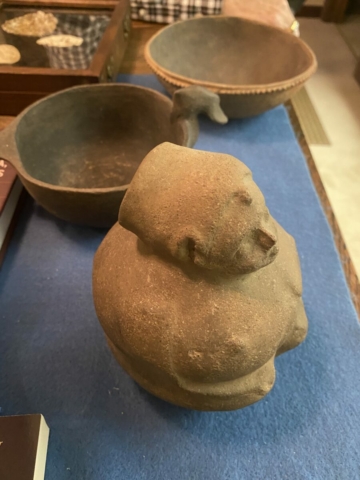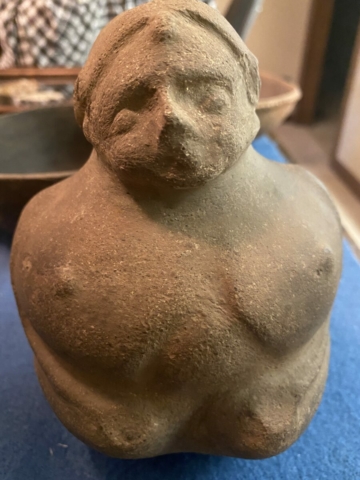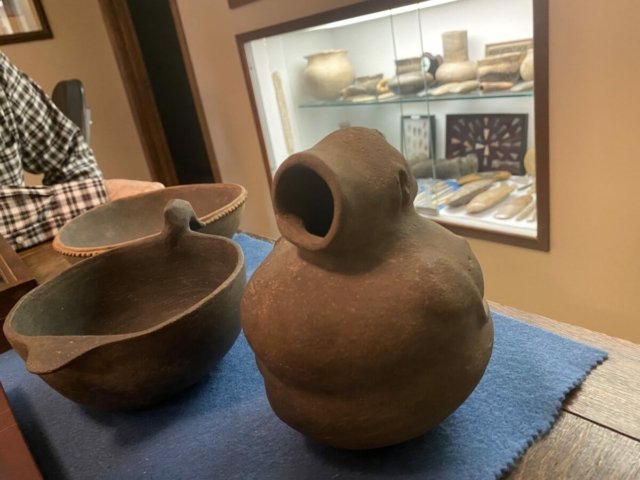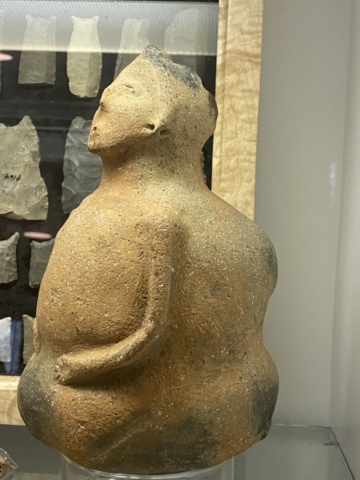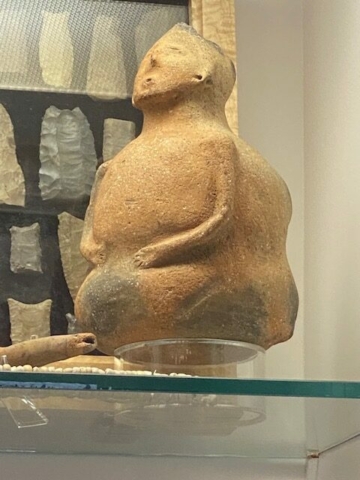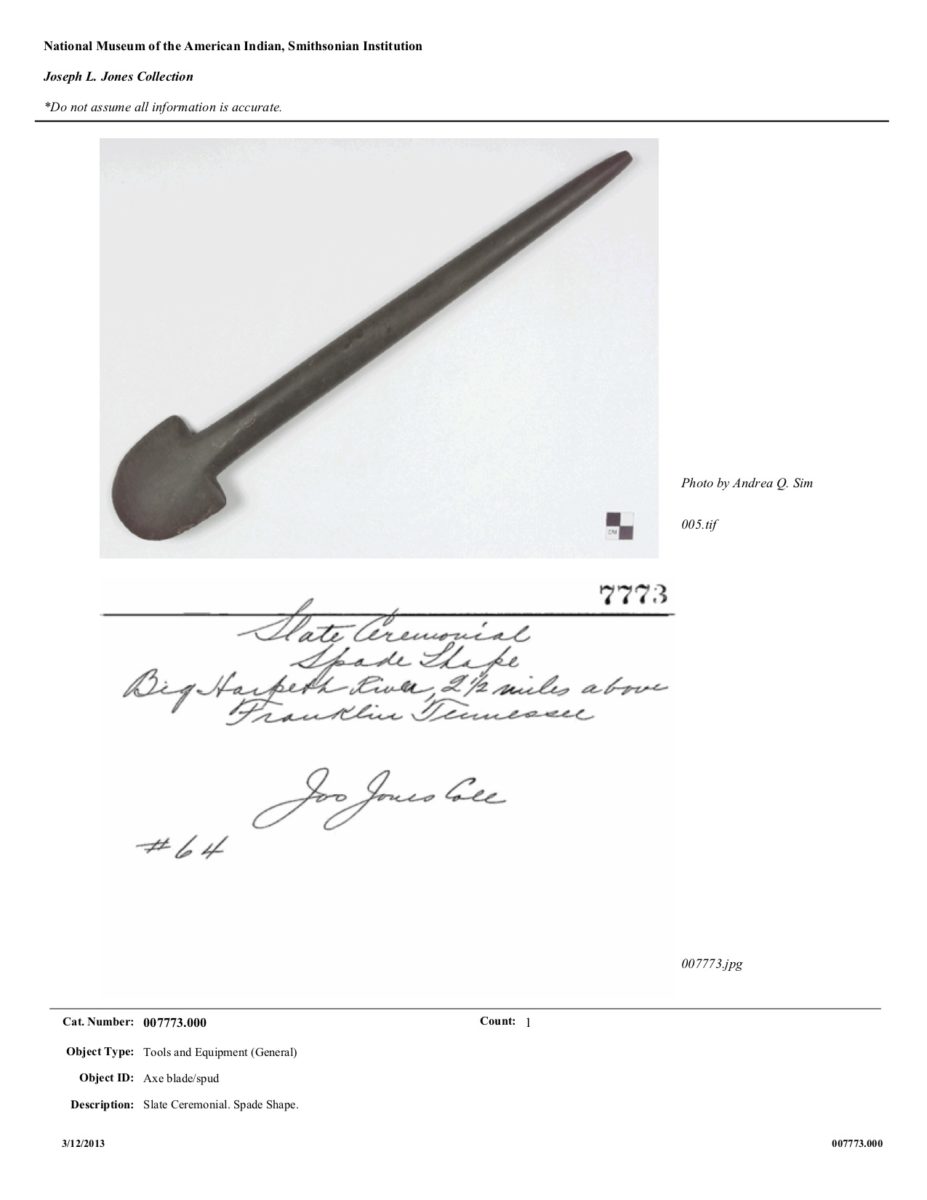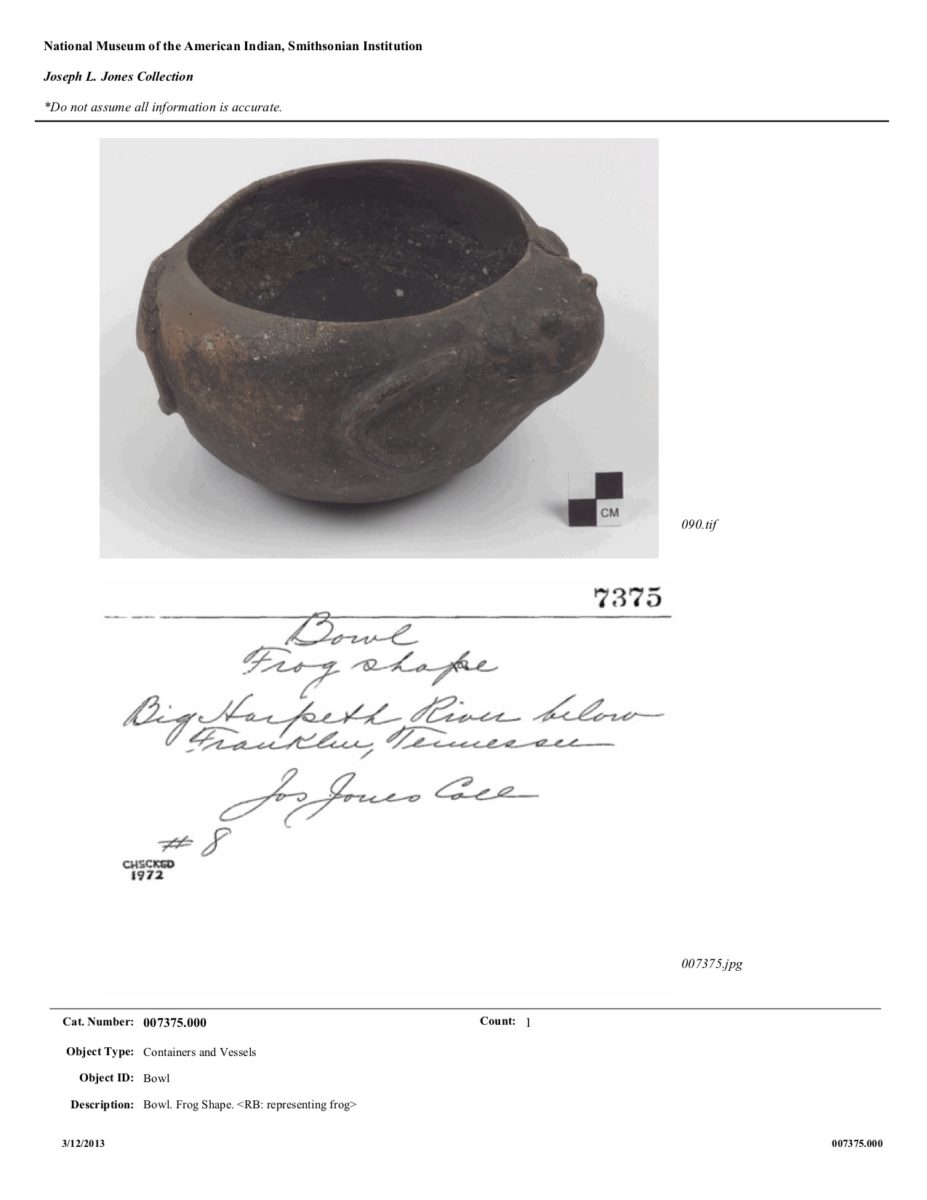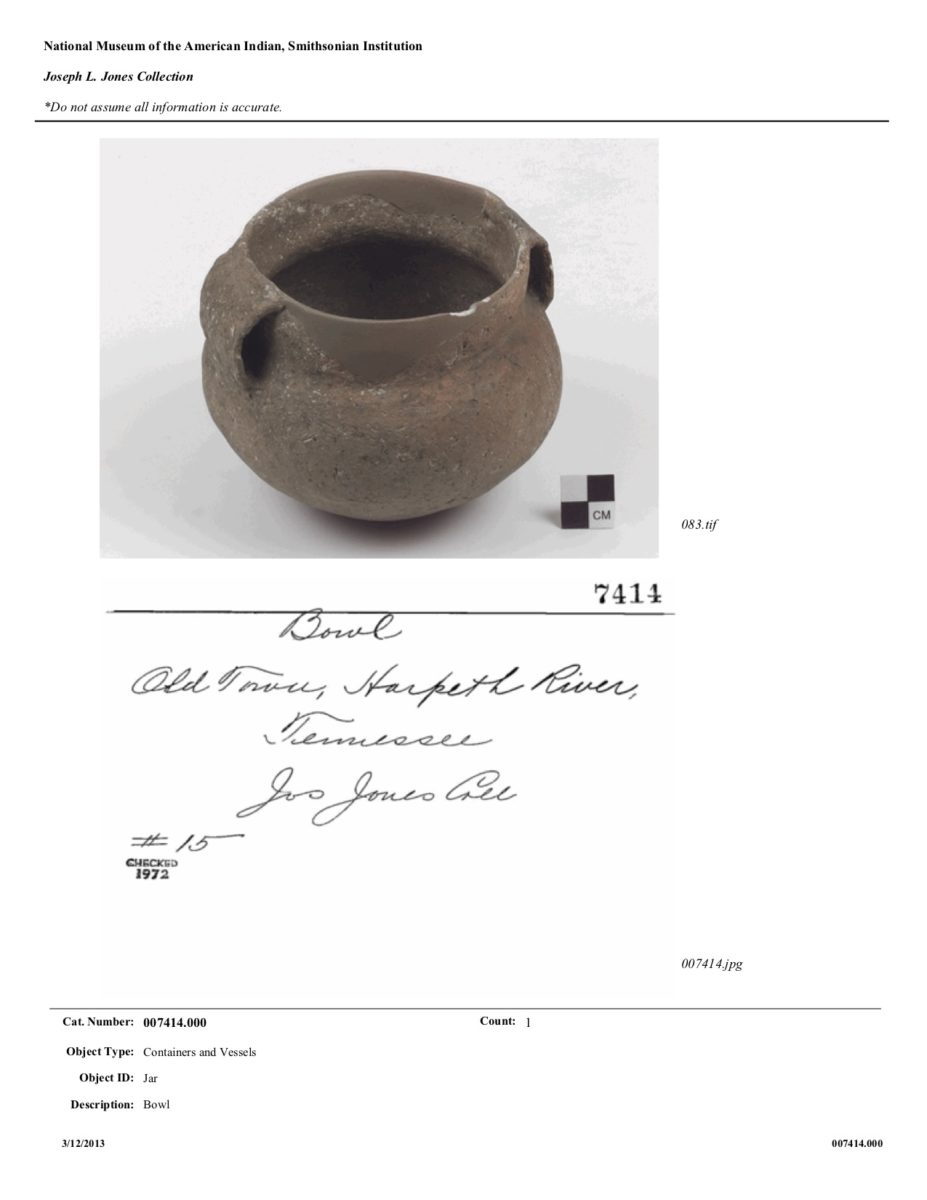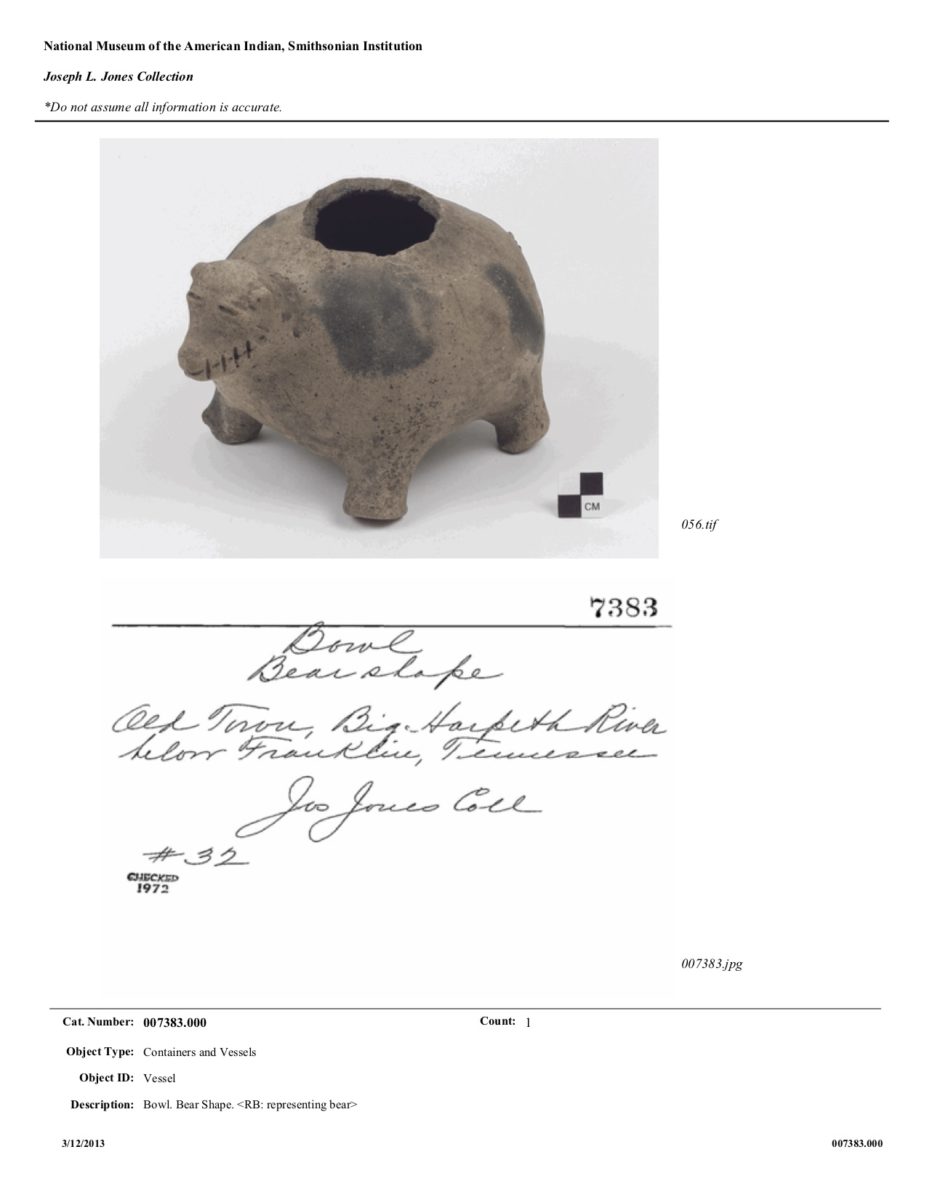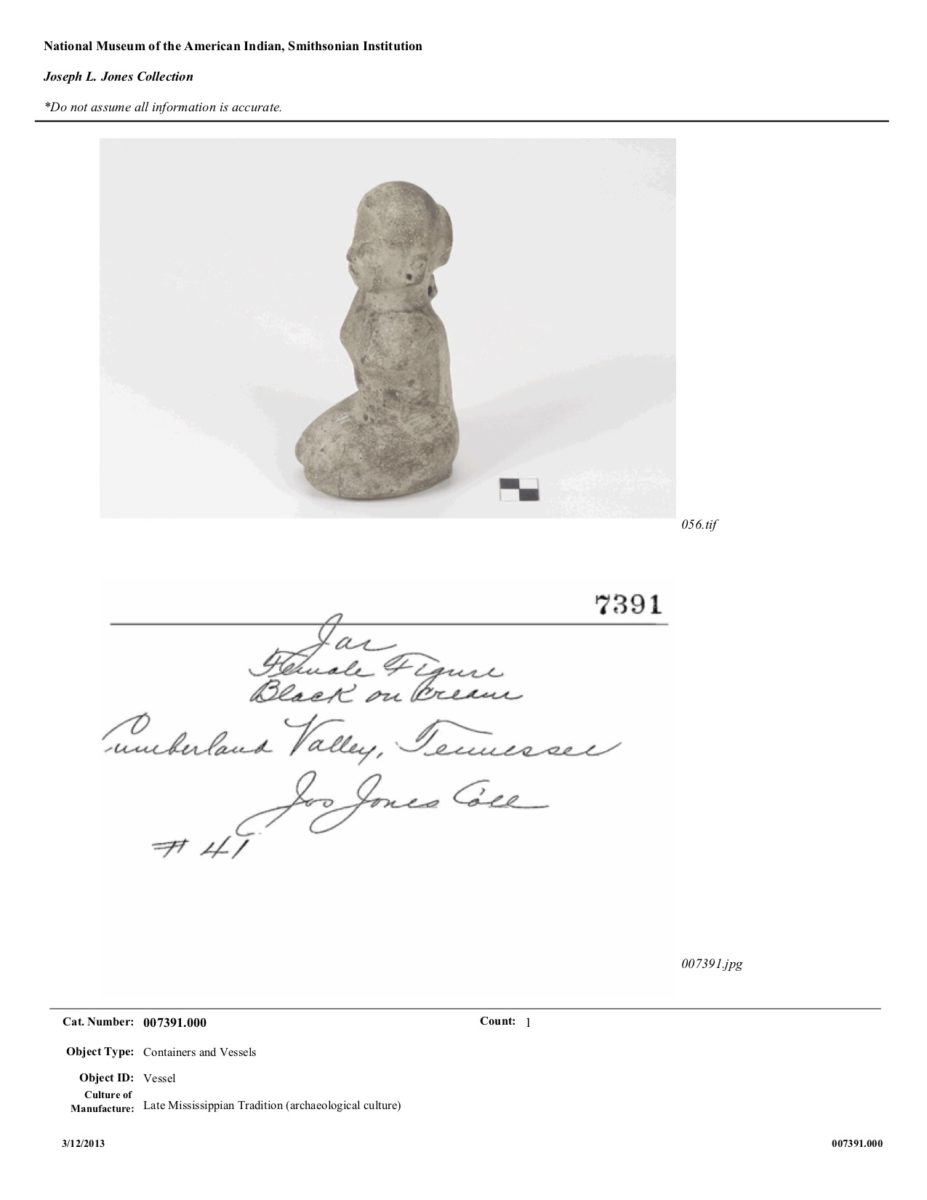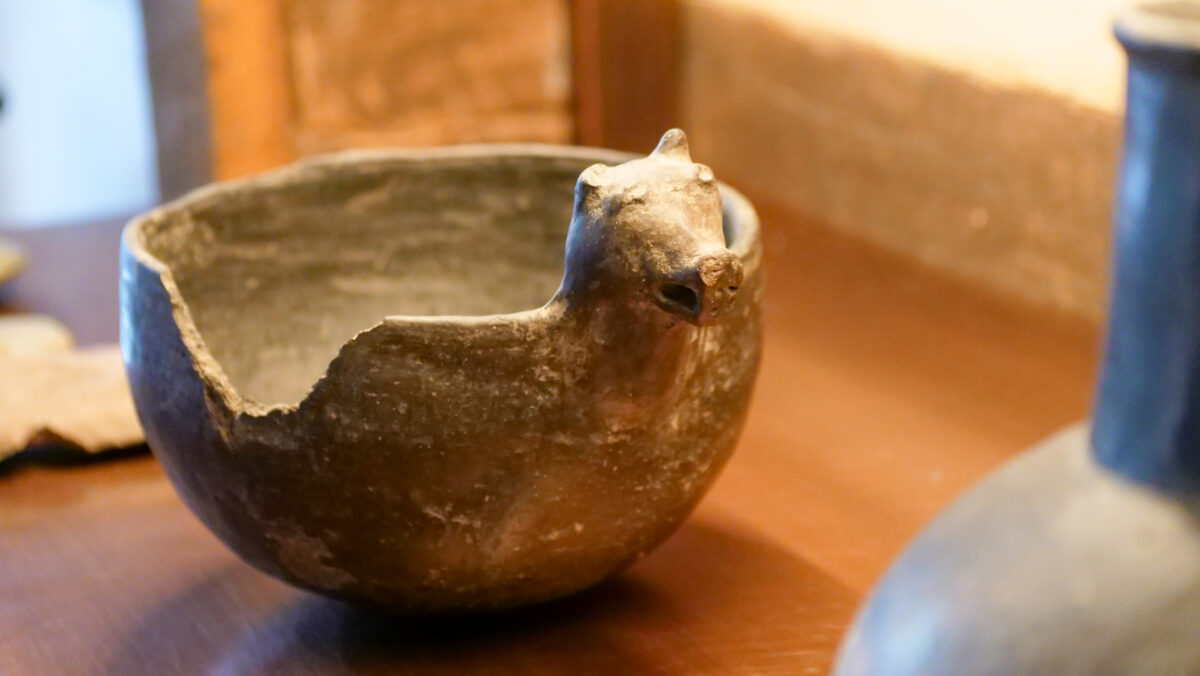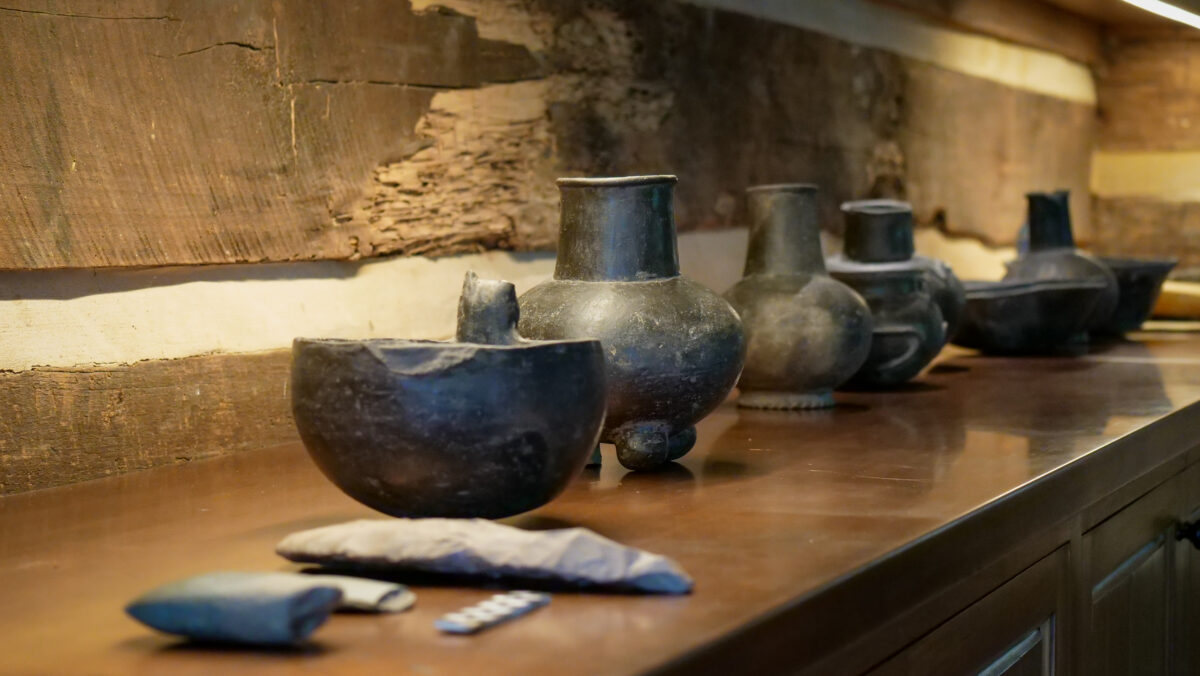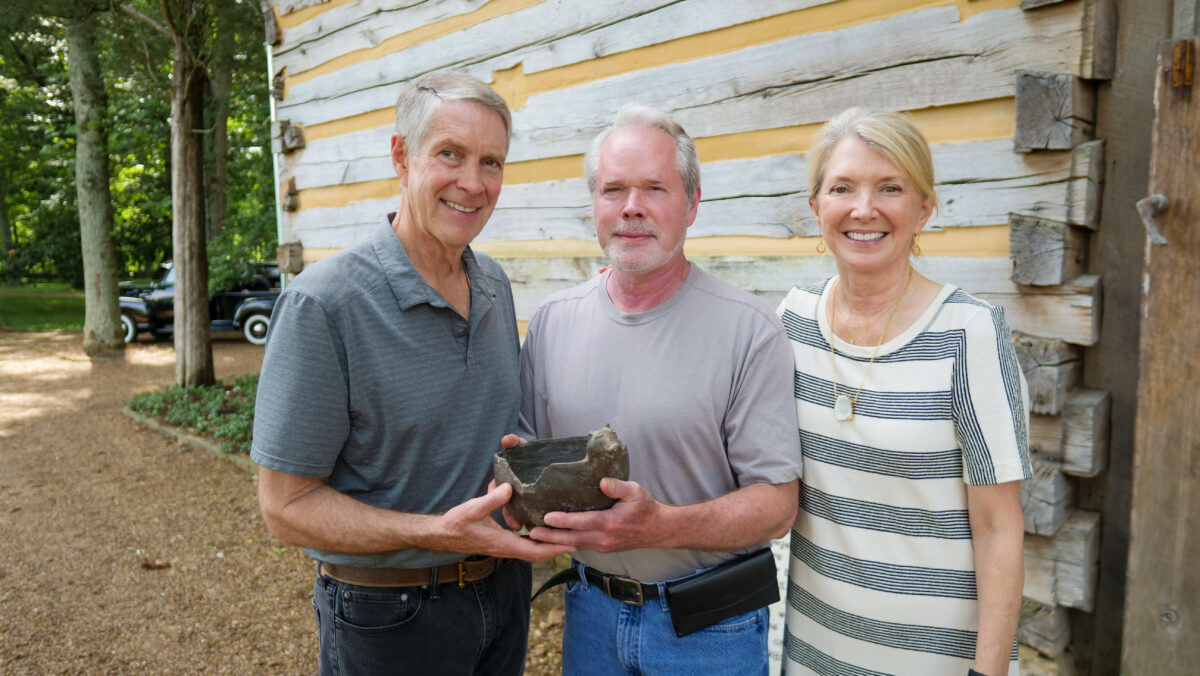Mississippian Artifacts Collection
Below, sacred collections from the Mississippian culture are respectfully shared. We at Old Town acknowledge and honor those who came and dwelled here before us, including the Mississippian, Shawnee, Cherokee, Chickasaw, and other peoples. We strive with humility, accuracy, reverence, and ongoing consultation to expand the knowledge and understanding of these cultures. We share these reflections of culture and humanity with appreciation and deep respect for those before us that have called the land at Old Town home.
Above: The female effigy bottle was previously stewarded by Byron McDonald (1946-2022), a long-time member and former officer of the Middle Cumberland Archaeological Society.
“This small vessel, made in the image of a kneeling female figure, is reported to have been found in the early 1900s on a family farm on Vivrett Creek, a tributary of the Stones River, not far from the Davidson County–Wilson County line. While these details of its discovery may seem simple enough, even for a family keepsake, several facts suggest that this bottle is a significant cultural artifact: first, archaeologists know that a number of such effigy bottles were made by indigenous women in small communities across this region of Middle Tennessee for about 200 years during the Mississippian period. Second, they recognize that this female—kneeling with her legs tucked under, her ropelike arms resting along her sides, and her hands held in front of her midriff—has been depicted with an extremely exaggerated spinal hump, delicately notched with vertebrae. Together, these attributes signify that this is not a representation of any human individual, but is much more like to be an idealization or visualization of a long-lived supernatural guardian or deity, such as an Earth Mother, believed to have been responsible for the full cycle of life, including health and well-being as well as women’s fertility and the caring of the souls of the dead. Thus, the woman who made this female effigy bottle may have done so to venerate the Earth Mother and solicit her for aid, comfort, and some assurance that the loved one she has lost may someday be reborn or otherwise restored to her and her community.” This description was written by Robert Sharp, independent scholar, researcher, writer, and former Executive Director of Publications at The Art Institute of Chicago.
The Female Effigy Bottle: A Portal to The 1000-Year Old Civilization that Once Thrived in Nashville
By Tristan Collins
The Mississippian Culture
Beneath the ever-expanding city of Nashville lie the remains of a 1000-year-old culture that continues to elude historians. The culture, known broadly as the Mississippian culture, employed no form of written language. Furthermore, many settlement remains are obscured by urban development, while others are lost to passing time. We often think of Nashville’s history in terms of European settlement, and its pivotal role in the Civil War, but hundreds of years prior, between 1000 AD and 1500 AD, a civilization of native peoples thrived.
The Mississippian culture predated what we think of today as the historic and modern day American Indian nations, with many of these later tribes descended from the Mississippian people. Much of what is known about the Mississippians is derived from the study of their burials. Numerous excavations of distinctive stone-box graves have been conducted over the centuries following their discovery by European explorers. Reports from these excavations, which often include detailed inventories of the objects discovered, allow historians to better understand how the sites appeared at the peak of Mississippian civilization, when the culture reached as far as modern-day Minnesota, Oklahoma, and Florida. Though excavation is less common today out of respect for the dead, surveys conducted using ground-penetrating radar allow archaeologists and historians to further visualize the layout of the once lively sites.
There are a number of cultural traits and relics distinctive of Mississippian culture. In the context of the Middle Cumberland Region, the area of central Tennessee stretching out on either side of the Cumberland River, perhaps the most distinctive pottery relic is the female effigy bottle. While relatively small in stature and consistent in design across settlements, these bottles were essential elements in mortuary rituals. They were likely used to encourage the preservation of life before their inclusion in graves. Many historians agree these figures represent a single supernatural personage, an Earth Mother deity, considered to be the supreme female deity of the Mississippian culture.
One of the few published experts on these civilizations, Middle Tennessee State University Professor of Sociology and Anthropology Kevin E. Smith, PhD, argues that the earliest examples of female effigy bottles were created at Castalian Springs, a mound center that still exists thirty-five miles to the northeast of Nashville. To provide context, the Middle Cumberland Region is believed to possess close to thirty of these mound centers, which are defined by the presence of large earthen mounds that served primarily as the foundations of ceremonial temples and other significant religious structures. While the temples are gone, these raised mounds, manually built by laboriously piling earth to create multiple-story-tall flattened pyramids, have lasted hundreds of years and demonstrate the scale and organization of these societies. These regionally established mound centers with robust palisade walls were a distinctive trait of the civilization, and were flanked by several hundred smaller surrounding settlements in the region. This network of settlements and centers likely shared a common belief system, in which the female effigy bottles played an important role. Evidence suggests t
The female effigy bottles originated around the late 1200s A.D., and have been found throughout the Middle Cumberland Region and beyond,.Indeed, a fragment of a bottle believed to have been created near Nashville was found over 300 miles away at Cahokia (in present-day Illinois), the largest of all the Mississippian mound centers.Because of their spiritual significance, it’s understood that the sculpting of these effigies was left to a trusted few. They are thought to be the work of female potters, who served a substantial religious role for the Middle Cumberland settlements. More speculative arguments posit that these potters were associated with one of a few “social houses,” which, according to Kevin Smith, are comparable to modern religious sects. These social houses were founded on a consistent set of mythological stories, differing primarily in how they emphasized particular characters. The “social house” presumably responsible for the female effigy bottles would have been dedicated primarily to the figure of the Earth Mother, discussed further below. The exact purpose of these vessels remains a subject of debate. It is, however, clear that they were involved in ceremonies related to sick or dying children, as the bottles are recorded to have been primarily discovered inside the graves of children. Often, the bottles were found alongside marine-shell gorgets, ornamental accessories built of shells imported from the Gulf Coast.
Appearance of the Female Effigy Bottle
The image above shows an example of a female effigy bottle. Standing somewhere between six and fifteen inches tall, these bottles are made of clay, meticulously shaped and then hardened using fire. The figures decorating the bottles share a number of similarities. They are generally depicted in one of two postures: either sitting with their knees clutched against their abdomens or kneeling with their legs folded beneath their bodies. They are dressed in short skirts, distinguishing them as representations of female characters. The status of the character is often indicated by a top-knot or earrings, both of which were reserved to elite individuals and deities. The similarities are perhaps partly on account of teacher-student relationships shared by distinct potters. Some suggest that two of the more prominent potters were a mother and daughter pair who oversaw apprenticeships that furthered a certain style of effigy. Kevin Smith explains that aspiring potters likely traveled to distant mound centers in order to study under well-respected potters and thereby hone their skills. Still, the distinct potters all seem to have made a conscious effort to communicate age and stage of life in the figures. Some of the effigies are depicted hunched over with protruding vertebrae. Others are depicted with straight backs marked by indentations distinguishing them obviously from the hunchbacked figures.
The humpbacked and straight-backed figures are generally believed to be representations of the same character: the Earth Mother. This claim is corroborated by a number of other observations. For example, the effigy figure’s garment remains consistent regardless of the figure’s posture. Symbols printed on this garment using a method known as negative-painting, in which the background of the design is painted while the design itself is left unpainted but visible, point to the character’s identity. The garment is generally distinguished by a hatched ellipse, an oval containing a smaller oval. Robert Sharp describes this motif as “signal[ing] a portal… between This World and the Beneath World or between This World and the Above World” (Sharp 27).
Mississippian Mythology
To fully understand the meaning of this symbol requires a cursory understanding of Mississippian mythology. The people who made up the Mississippian culture believed in the existence of three realms: the Above World, the Middle World, and the Beneath World. The Middle world was the world of experience, while the two worlds bordering it were occupied by non-human characters. Though these three worlds were understood as distinct, interaction between them was understood as a possibility. This interaction between worlds took multiple forms. For example, the people believed that if they honored the non-human entities sufficiently, the non-human entities might reward their devotion by granting them a gift or special ability. David Dye, a professor of archaeology at the University of Memphis, offers another example of interaction between worlds, describing Mississippian belief in the existence of two souls, the life soul and the free soul, the latter of which could detach from the body. This separation of soul from body occurred during states of unconsciousness, including death. On the occasion of death, the soul would depart the Middle World for the Beneath World. However, the soul was not doomed to remain there forever. It was the responsibility of the Earth Mother, one of the characters most central to the Mississippian belief system (as well as to the belief systems of numerous tribes across the Americas), to see that the free soul returned to the Middle World and attached itself to a new body. This was the structure of the Mississippian understanding of reincarnation. Through this process, one might understand the meaning of the symbol imprinted on the effigy bottles: the portal design on the garment is likely a reference to the Earth Mother’s significance as an administrator of reincarnation.
The responsibilities of the Earth Mother were not restricted to the facilitation of reincarnation. She was also associated with fertility. She was likely the subject of the devotion of pregnant women and their families, as well as of farmers struggling to grow crops. The conditions of the late Middle Cumberland Region were, thus, tuned to suggest her importance. For well over a century leading to the dispersal of its population, the region was plagued by serious droughts that contributed to a staggering infant mortality rate, which analysis conducted by Kevin Smith indicates occasionally surmounted 70 percent.
Interpretations of the Female Effigy Figure
While historians agree on the identity of the effigy figure, they offer a number of subtly different explanations for the cultural significance of the bottles. These include use in the difficult process of childbirth, to hold medicine for ill children, and perhaps, most interestingly, to allow for reincarnation of children’s souls.
During its later years, the region was destabilized by droughts and failed harvests. As a consequence, the population faltered. The people of the region seem to have been desperate for a resurgence. Of course, individuals had sentimental reasons for desiring successful births, but it is also true that the distinct settlements required population maintenance and growth to survive. It was not uncommon for distinct settlements to raid their neighbors in the hopes of acquiring desperately-needed resources. The potential for raids drove settlements to frantically erect palisades, efforts which demanded enormous human labor. Kevin Smith contends that the effigy bottles were crafted to dispense medicine to sick and dying children, then, if the medicine proved to be unsuccessful, buried alongside the body in the hopes that it would facilitate the reincarnation of the child’s soul. Reincarnation is a commonly held belief among American Indians and their predecessors, and could be a method to continue a family line that has died out – allowing for the passage of family traditions, skills, and hierarchies.
One question that remains concerning the female effigy bottles relates to the symbol on her garment. Outside of the Middle Cumberland Region, the symbol has appeared most regularly in association with male figures, perhaps most prominently the Hero Twins (mythological brothers often represented as thunderbirds, who supposedly joined forces to get revenge for their mother’s murder). In the Middle Cumberland Region, however, the motif is generally used to decorate the Earth Mother figure. This dramatic difference in the application of the symbol is still not fully understood.
To conclude, while much is known about the female effigy bottles of the Middle Cumberland Region, much more remains subject to speculation. While limitations (such as the absence of a written language and the obstructed nature of the remaining historical sites) present historians with difficulty, they also inspire archaeologists and historians with excitement. Doubt is an opportunity to discover. And, perhaps fittingly, it is through these effigy bottles that historians conduct much of their research. The bottles, like the portals they represent, transport viewers to the culture of fourteenth century Tennessee.
Below are highlights that demonstrate the variety of the Collection. The entire Mississippian Mound Artifacts Collection can be viewed here.

